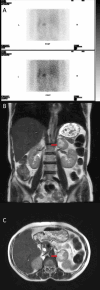Severe and Prolonged Hypoglycemia Following Adrenalectomy for Pheochromocytoma: A Case Report
- PMID: 40726849
- PMCID: PMC12301866
- DOI: 10.7759/cureus.86880
Severe and Prolonged Hypoglycemia Following Adrenalectomy for Pheochromocytoma: A Case Report
Abstract
We report a case of a 64-year-old woman with poorly controlled diabetes mellitus who was found to have a left adrenal pheochromocytoma. Despite standard preoperative management including alpha-blockade with doxazosin, the patient developed persistent and severe hypoglycemia immediately following adrenalectomy, requiring high-rate intravenous glucose infusion. Markedly suppressed preoperative urinary C-peptide levels rapidly increased after surgery, indicating reversible beta-cell suppression due to catecholamine excess. Over a 10-year postoperative course, the patient maintained stable glycemic control with dietary therapy alone, demonstrating substantial improvement in glucose metabolism. This case highlights the rare but significant risk of postoperative hypoglycemia even under optimized perioperative conditions, and illustrates the potential for long-term improvement in diabetes following pheochromocytoma resection.
Keywords: adrenal pheochromocytoma; catecholamine excess; glucose metabolism; hypoglycemia; insulin sensitivity; postoperative hypoglycemia; secondary diabetes.
Copyright © 2025, Kawasumi et al.
Conflict of interest statement
Human subjects: Informed consent for treatment and open access publication was obtained or waived by all participants in this study. Conflicts of interest: In compliance with the ICMJE uniform disclosure form, all authors declare the following: Payment/services info: All authors have declared that no financial support was received from any organization for the submitted work. Financial relationships: All authors have declared that they have no financial relationships at present or within the previous three years with any organizations that might have an interest in the submitted work. Other relationships: All authors have declared that there are no other relationships or activities that could appear to have influenced the submitted work.
Figures



References
-
- Pheochromocytoma: an approach to diagnosis. Sbardella E, Grossman AB. Best Pract Res Clin Endocrinol Metab. 2020;34:101346. - PubMed
-
- Prevalence of functioning adrenal incidentalomas: a systematic review and meta-analysis. Sconfienza E, Tetti M, Forestiero V, Veglio F, Mulatero P, Monticone S. J Clin Endocrinol Metab. 2023;108:1813–1823. - PubMed
-
- Screening for phaeochromocytoma: in which hypertensive patients? A semiological study of 2585 patients, including 11 with phaeochromocytoma [Article in French] Plouin PF, Degoulet P, Tugayé A, Ducrocq MB, Ménard J. https://pubmed.ncbi.nlm.nih.gov/7208288/ Nouv Presse Med. 1981;10:869–872. - PubMed
-
- Phaeochromocytoma. Lenders JW, Eisenhofer G, Mannelli M, Pacak K. Lancet. 2005;366:665–675. - PubMed
Publication types
LinkOut - more resources
Full Text Sources
